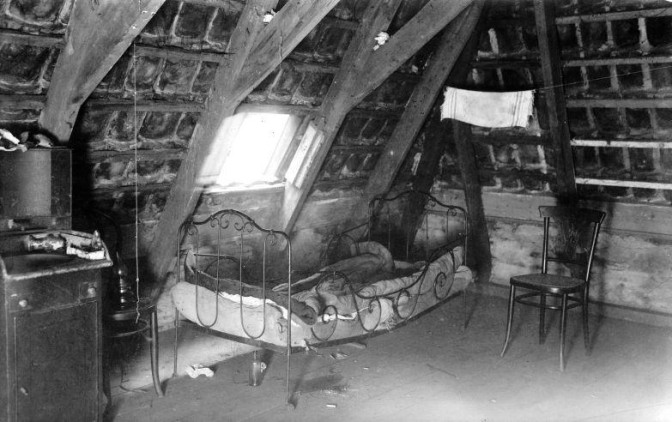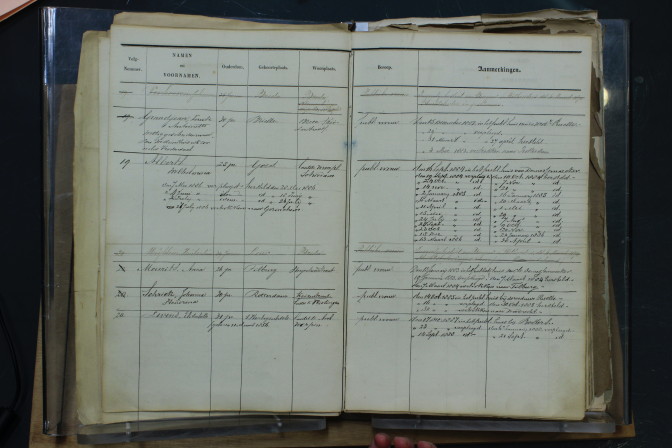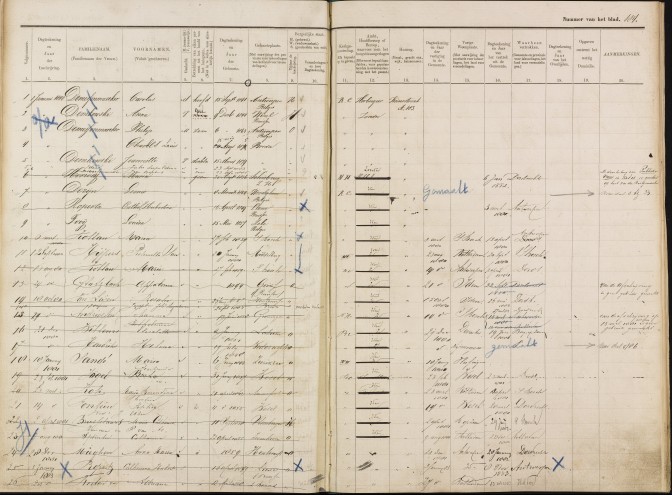Last week, I went looking for prostitutes. Dead ones. Found them too. Now that I have your attention, let me explain how this came about.
As I wrote in the case study subtle clues in population registers, I have been looking for the father of my ancestor Maria Cornelia Platschart since 1991. Maria Cornelia was born in Breda, the Netherlands, in 1861, the illegitimate daughter of Cornelia Platschart. I now have a candidate for her father: Franciscus Bovendeert. The case study shows he was living with Cornelia Platschart before Maria Cornelia was born, even though he didn’t marry Cornelia until three years later.
I did some more research into Cornelia Platschart and uncovered some interesting facts. While living in Breskens, a garrison town in the Dutch province of Zeeland, Cornelia shared a house with two other unmarried women, who both had illegitimate children.1 Cornelia herself conceived an illegitimate child while living there and moved to Breda before he was born.2 In Breda, Cornelia first lived in a street called Antwerpsche Barakken (Antwerp barracks), a slum notorious for prostitution.
You can see where this is going right? Could Cornelia have been a prostitute? Needless to say, that would seriously undermine my tentative conclusion that Franciscus Bovendeert was the father of Maria Cornelia. I just had to find out!

Bed of a prostitute. Credits: Spaarnestad Photo
Health risk
I asked Wilma, a historian who wrote her Master’s thesis about prostitution in 19th century Haarlem, if she knew how to go about proving or disproving that Cornelia was a prostitute. She explained to me how the attitude of the government changed over time and which traces this left in the archives.
In the 19th century, the government worried about the health of the clients. Towards the end of the 19th century, the men weren’t seen as victims but rather as the perpetrators who gave diseases to these women and to their wives and prostitution (including visiting prostitutes) became illegal. This fits into a larger pattern of women’s rights and the suffragette movement. Towards the end of the 20th century, prostitution was legalized again in order to better protect the rights of these women.
Cornelia had her illegitimate child at a time when the government was mostly concerned about the health of the clients of prostitutes. To ensure that the women did not give their clients any diseases, weekly visits to a doctor were mandated. If found to be ill or contagious, they would not be allowed to work until cleared during a next check-up. Prostitutes who settled in a town were issued a booklet where these check-ups were recorded that they were to keep with them. The police recorded these check-ups as well. In some cities, these records have survived. Wilma knew that the Breda records of the medical check-ups still existed and supplied me with the call numbers I needed to consult the records in the archives.
While discussing this case on Twitter, we decided to go to the Breda archives together so she could consult the records for her own research. We were joined by Lineke, another archivist/researcher who lives in Breda who wanted to do some research into the history of her house, that happens to be on the same street as the house of my ancestor Cornelis Flooren (but that’s a story for another day).
Registers of public women
The Breda archives keep two registers of public women: 1870-1896 and 1896-1906. Unfortunately, that was too late for my own research but I was fascinated by the detailed information that these registers provided. For each woman, the following information was listed:
- Name
- Place of birth
- Age or date of birth
- Address and/or bawdy house
- Dates when they were unfit to work, sometimes listed as ‘verpleegd’ [being nursed], but sometimes as ‘besmet’ [contaminated].
The registers also contained several loose papers, that included affidavits by doctors and extracts from birth records or population registers of previous places of residence of the women.
Example: Wilhelmina Alberts
Take Wilhelmina Alberts for example, a 25-year-old woman from Goes in Zeeland. The prostitute register tells us she settled in Breda on 16 September 1884 when she joined the bawdy house of Demessemaecker. She was “verpleegd” [being nursed, i.e. ill] just three days later and was not allowed to work until 10 October, only to become ill again two weeks later. She was unfit 15 times in less than two years. Sometimes she was just allowed to work for a week when the inspection declared her unfit again. On 27 July 1886 she left for Gorinchem.3 Wilma remarked that she was surprised that the bawd did not dismiss her.
A couple of pages later, she’s back in Breda, in her old bawdy house of Demessemaecker. She had been in Gouda but moved back to Breda on 8 September 1888. This time, the register lists her full birth date: 29 October 1858. She was ill again within the week and was not allowed to work from 14 September until 21 September 1888, after which she disappears from the records.4
I checked the index of the population register of Breda for 1880-1890 but she wasn’t listed. I did find the household of the bawdy house.5 The head of the household was Carolus Demessemaecker, “herbergier” [innkeeper]. Besides his wife and three children, no less than 42 women lived there for shorter or longer periods of time between 1880 and 1889. Interestingly, the first entries of the women who lived with him had “publieke vrouw” [public woman] as occupation, but that was struck through and corrected to “zonder” [without]. Later entries of the women in his household had no occupation listed.
It will be interesting to correlate the information from the prostitution registers with the population register. I’m sure there are other examples besides Willemina Alberts where women appear in the prostitution registers but not in the population register. Similarly, some of the women listed as ‘publieke vrouw’ in the household of Carolus Demessemaecker do not appear in the prostitution list. So neither registration is complete, but together they offer a rare glimpse into an aspect of 19th century life that I previously knew nothing about. And before you ask: no, they did not record their clients. There are some records that even the Dutch don’t keep.
So what about Cornelia Platschart?
Since the prostitution registers only started in 1870, when Cornelia Platschart was already 50 years old and had been married for six years, the fact that she did not appear in the registers doesn’t really say much. But the research did tell me how women who were prostitutes appeared in population registers. I will do some more research, but the examples that I checked had these women living with innkeepers, in households with many other unmarried women. They were either listed as no occupation or as public women. This does not match Cornelia’s appearance in the population registers. When she got pregnant with Maria Cornelia, she was living by herself.
So do I think Cornelia was ever a prostitute? To be honest, I’m not sure. She could have been one in Breskens, when she lived with two other unmarried women in a house and they all had illegitimate children. Further research into Breskens police archives may turn up relevant information about that period of her life. But as Wilma explained to me, there were many women who were only prostitutes for a while, until something better came along. So even if Cornelia was a prostitute in Breskens, this does not mean she was one in Breda ten years later, when she got pregnant with my ancestor Maria Cornelia. From what I’ve seen about her in the Breda population register, she doesn’t match the prostitute profile. Unless and until new evidence turns up, I am concluding that she was not a prostitute when she got pregnant with Maria Cornelia, my ancestor.
Together with the other evidence I have collected that showed that Franciscus Bovendeert was living with her before her child was born, I think that he probably was the biological father. I will be researching his ancestry in the hope that I will be able to find a paper trail from one of my DNA matches to his ancestors.
Download photographed registers
So are you curious to see if any of your own ancestors show up in these registers? I photographed both registers and created PDF files with bookmarks for you to download. Both registers have a contemporary index in the back in case you want to check for familiar names.
More information (Dutch)
- Prostitutie in de 19e eeuw [prostitution in the 19th century], Wilma’s weblog
- Hoeren in archieven [whores in archives]
Sources
- Breskens, Bevolkingsregister [population register] 1850-1861, part 1, p. 30, Cornelia Platschart in household of Janneke de Booij; “Netherlands, Census and Population Registers, 1645-1940,” images, FamilySearch (https://familysearch.org/pal:/MM9.3.1/TH-1971-30856-9425-28?cc=2018408&wc=MMBC-BSF:383363400 : accessed 31 October 2013), Zeeland > Breskens > Bevolkingsregister 1850-1861 > image 36 of 495.
- Breda, bevolkingsregister [population register] 1850-1859, part 5 p. 984, household of Cornelia Plutschaart [sic]; “Digitale Stamboom” [Digital family tree], index and digital images, Stadsarchief Breda (http://stadsarchief.breda.nl : accessed 26 October 2013)
- “Ingeschreven publieke vrouwen” [registered public women] 1870-1896, call number 846, entry 19, Wilhelmina Alberts; Gemeentepolitie [Municipal police] Breda, record group 43.1; Stadsarchief Breda [Breda City Archives], Breda, The Netherlands
- Ibid., entry 66, Wilhelmina Alberts.
- Breda, Noord-Brabant, Netherlands, population register 1880-1889, part 2, p. 184-185, household of Carolus Demessemaecker; “Digitale Stamboom” [digital family tree], digital images, Stadsarchief Breda (http://stadsarchief.breda.nl : accessed 7 January 2014)




Please note the change in e-mail address.
Interesting that you write of Prostitution in the Netherlands today while I am writing of Prostitution in Missouri, USA, in 1870. I am writing the history of an infamous ancestor (sister of my great-great grandfather) who was a prostitute in St. Louis, Missouri in 1870. Different time and different place, but same profession. Interesting.
What a coincidence indeed! What types of sources are available for research into prostitution in Missouri in the 1870s? Was prostitution legal or illegal? I bet it’s easier to find records if it was illegal and people were being prosecuted for it. Was she one of the Dutch immigrants or their children? I’ve never come across any prostitutes in that group and would find it fascinating to know about.
Very interesting article again Yvette!
Thank you for sharing this!
Greets
Irma
You’re welcome! Glad you enjoyed it!
Very interesting indeed. Are there any records on unwed mothers? Are they listed differently on censuses?
Unwed mothers are recorded as such in birth records. If they were confessed members of the Dutch Reformed Church, it is likely that they were censured by the church council and you may find them in the church council minutes. In population registers you can spot unwed mothers by the fact that their children will have the same last name as them (women are listed under their maiden names so legitimate children have a different surname than their mothers), which you can them confirm in the birth records. I did that for all of the children of the other women in the household that Cornelia lived in in Breskens, but that would go too far for this article.
I see a blog post about finding unwed mothers in my future 🙂
Thank you! Like I said before, I am related to the Nekkers from Winterswijk. On your family tree papers Hanna Berendina Nekkers is the mother of a Hendrik Willem Nekkers. I know she lived in Albany NY for a while when she first got to the US. She then moved to Forestport NY with her son who was William King here in the US. Her husband was Henry King, and it states in his obit that Hannah passed away just after they came to Forestport NY. She must have been an unwed mother. The family had a lot of run ins with the police. They must have been going through tough times.
I know that here in America, in Forestport NY, they went to a German Lutheran church. I appreciate all your help and guidance. Kathy
To reassure you: Hanna Berendina Nekkers was probably just an unfortunate girl who got pregnant with a man who couldn’t or wouldn’t marry her. I have never heard about any organized form of prostitution going on in Winterswijk, which makes sense as it was not a garrison town like Breda.
Did you check where Hanna Berendina Nekkers lived when she conceived her illegitimate child? You should be able to find that information in the population registers. An index to the Winterswijk population registers plus scans is available here. If she was a live-in servant, like many girls in their late teens and early twenties in Winterswijk, the employer or his sons would be good candidates to be the father. There may also be information about her being censored for having an illegitimate child in the church council minutes. I always advise to check the church council minutes for the period between six months before the birth (when she would have started showing) to six months after the birth. For Winterswijk, the church council minutes are not available online but can be accessed on-site at the Achterhoek Heritage Center in Doetinchem.
Thanks so much for all your information! I find it so fascinating that with just inanimate objects like these records, one can find so much out about relatives that lived almost two hundred years ago. Kathy